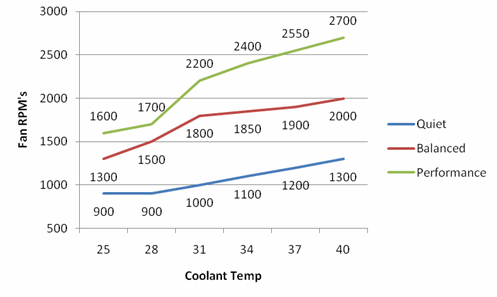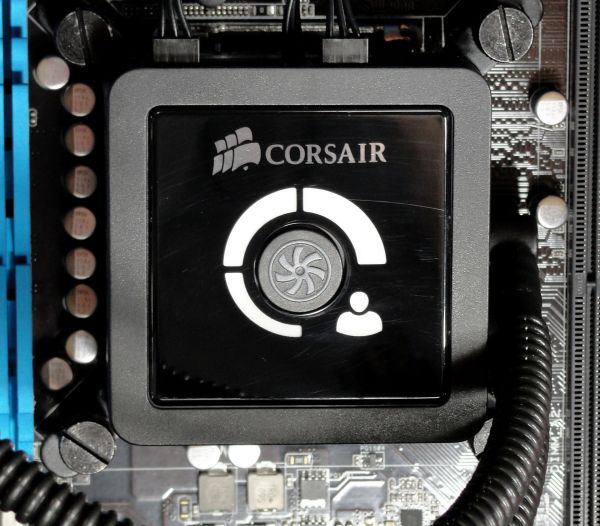Corsair Hydro Series: H60, H80 and H100 Reviewed
by Jared Bell on November 7, 2011 12:00 AM EST- Posted in
- Cases/Cooling/PSUs
- Corsair
- Water Cooling
H60, H80, and H100 Overview
As always with Corsair products, packaging and box art are top notch. We’ll start with the lowest tier offering, the H60, and then move to the H80 and H100.
H60 High Performance Details
The H60's radiator is the same size of the previous generation H50. However, the H60 has a new, upgraded water block that allows for more efficient flow. It also has the adjustable 90 degree connectors we've seen on the H70 making installation easier. Corsair provides a single 120mm 1700RPM PWM fan. The inclusion of a PWM fan is a nice touch since most motherboards have the needed 4-pin connector and have BIOS settings for easy fan speed control. This means the cooler can be virtually silent when idle, but ramp up the RPMs (and therefore noise) as needed. As mentioned, the H60 only includes one fan, but you can add a second fan for a push/pull configuration. You'll just need to pick up an extra set of 6x32x1-1/4" screws.
H80 High Performance
The H80 takes over for the H70 with its thicker radiator design but shares the same new, upgraded water block as the H60. However, the H80 and the H100 have an all new push-button fan control that lets you select the fan speed and cooling performance setup that best suits your needs. The white LED display lets you know which profile is being used. The H80 can power and control up to two fans. Thankfully, like the H70 before it, the H80 already comes with two fans for a push/pull configuration. The included fans are 3-pin and spin at 2500RPM when the fan controller is set to its highest setting. We’ll provide more information on the fan speed profiles later.
H100 Extreme Performance
The H100 is an all new double-wide design sporting a 240mm [or 2x120mm] radiator that has the same thickness as the H60. The water block and fan controller are the same that we've seen on the H80; however, the H100's fan controller can power and control up to four fans even though the unit only comes with two. This gives you the option of adding two more fans for push/pull on this bad boy. The two included fans are the same high speed 2500RPM fans that come with the H80.
Fan Controller
The three speed push-button fan controller on the H80 and H100 is a great improvement over what Corsair offered previously with the H70. The H70 included two inline resistors for providing a second, lower fan speed. The new built-in fan control system on the H80 and H100 gives you three settings to choose from: low, medium, or high—or as Corsair calls it: low noise, balanced, and high performance. While some may complain you have to open your case to make changes, I think of it as more of a set it and forget it type thing. Corsair doesn't stop there though; each speed setting or profile actually has an RPM range for the fans to spin at. This means the fans will be quieter when idle and only reach their max rated RPM (and max noise) for that particular profile when the coolant inside reaches a certain temperature. Could this lead to the perfect balance of performance and noise? We'll hopefully find out with our tests in just a moment.

Corsair Link
The H80 and H100 both support Corsair's Link Digital, which is their suite of hardware and software for monitoring various system parameters. It also allows you to customize your own performance profiles. We don't have one of the Corsair Link's on hand, so we will not be testing this feature. It's unfortunate that Corsair doesn't include the Link with the H80 or H100, but I'm guessing they opted to make it optional so the price wouldn't go through the roof.



























91 Comments
View All Comments
ypsylon - Monday, November 7, 2011 - link
What advantages bring Closed Liquid Cooling solution. Yes big air coolers like Noctua DH-14 or Thermalright/Cogage Silver Arrow (using one of those) easily outperform CLC. But nobody is thinking about how much problems such big radiators bring to your life. Not everybody own case with horizontal motherboard (I do). In standard vertical mounting bolting 2kg to motherboard is a risky business. It can easily bent, brake and destroy brand new and spangling board you just bought. Need some work to reduce stress on the motherboard. From my own experience, I had that problem when I went from vertical to horizontal. There was certainly microscopic bent on CPU socket because short time after switching when board warmed up everything crashed to hell. Screwing everything even tighter helped for a week, but then whole circus started again. After replacing the board problem was gone, but that is the possible problem with humongous radiators. On the other hand CLC are small, weight very much nothing, performance is very good, often on par with extreme air coolers. Of course standard open LC is better option but it cost much more. If you don't do extreme OC and all what you need is excellent cooling for affordable price with minimum clutter around CPU socket then CLC is simply UNBEATABLE! Simples.What I don't like about these Corsairs is that stupid LED display on top of them and that you need to replace fans for something really useful (well all CLC have this problem).
As for why big air coolers still outperform CLC answer is fairly simple: Radiator thickness. 27mm is very thin for an radiator in liquid cooling setup. If they put 50+mm one day then air coolers will be dead. And I mean D.E.A.D.
Tetracycloide - Monday, November 7, 2011 - link
If you don't do extreme OC and all you need is excellent cooling for an affordable price expensive CLCs or expensive big air coolers are easily bested by fairly simple parts. If there's no extreme OCs any of the price points offered by corsair for CLCs are more than you should spend really and price/performance wise the CLCs are actually pretty poor performers relative to standard air coolers. The only thing CLCs really offer are space savings, they trade space around the CPU for space around an exhaust fan which is some chassis is a very good thing.Beenthere - Monday, November 7, 2011 - link
Exactly. Those were my points. The CLC's are a poor value, inefficient and over-rated. One leak can cost you hundreds of dollars is damaged PC hardware.Mediarocker - Sunday, December 18, 2011 - link
Inefficient? Hardly. They perform as well as most air coolers, with the exception of the giant Noctunas and ETC. but when it comes down to it, and you need space savings these are perfect for the job.So no they aren't of a Poor Value, and aren't inefficient and over-rated. They just don't belong in YOUR market segment.
Just because you don't have any use for it doesn't mean that they don't have a place to belong.
Nevertheless these CLC's won't leak as easily due to there being less user error. The CLC's are sealed shut. So leaking is highly improbable without there being some abuse involved, E.G. taking a screwdriver to the rad accidentally.
Take your fears elsewhere. It's been established that you are afraid of liquid cooling and prefer air cooling. That is entirely alright, but don't dismiss the merits of CLC cooling just because it has no use for you.
jed22281 - Monday, November 7, 2011 - link
All-in-one's from Swiftech (latest rev H20-220 etc) & similar specialist vendors are far better performers than the H100.And they're more flexible when it comes to adding your own tweaks/improvements etc.
jed22281 - Monday, November 7, 2011 - link
Pop over to xtremesystems where everyone talks about nothing but water-cooling.And they'll recommended it any day over the sealed loops from Corsair.
Fastidious - Monday, November 7, 2011 - link
Why not include some good cheap air heat sinks as well for comparison as well? I really don't see how this is recommended by Anandtech, very expensive with no major advantages along with added complexity and danger of leaks. It also seems impossible to refill these if they are losing liquid? They do have nice 5 year warranties but I suspect most air heat sinks will last much longer.Iketh - Monday, November 7, 2011 - link
heat pipes would need refilling if they leaked too... your point is mootkyuu - Monday, November 7, 2011 - link
Part of the whole point of closed-loop (these) vs. open-loop water-cooling is that they are much less complex (from the article, it seems that they're actually easier to mount than many traditional air HSFs), and, since they're sealed, there should be no danger of leaks (unless the unit is defective, in which case I'd assume the warranty should cover replacement of any damaged components). And of course it's impossible to refill them... again, they're sealed. You shouldn't have to worry about loss of liquid for the same reason.Personally, I love the idea of the CLCs (water-cooling performance without the expense, trouble, and risk of an open loop water-cooling setup), but unfortunately it's just not there yet. While it does provide a good alternative to mounting bulky, heavy air-coolers, you still have to pay a premium to get merely competitive performance with cheaper airs.
Hopefully, soon they'll be able to get these to outperform air-coolers as a water-cooler should.
mrjoltcola - Monday, November 7, 2011 - link
Maybe I missed it, but I see no mention of fan direction / configuration. For the H60 in particular it is important to mount the fan to push into the case/radiator.The H100 + 600T is really not the best test for that cooler. I reported this to Corsair tech support after I bought the combo, and they wouldn't even admit there was a problem. The grille between the top slot and the radiator causes major turbulence if you mount the fans to push into the case the fans vibrate like crazy. I had to do the same thing Jared did, leave the top grille off. Unacceptable for the money spent, considering Corsair claims compatibility. They were no help, though.
I opted to buy a 650D to move my rig into, but Corsair messed up with the 600T. Most of their other cases are perfect for the H100, though.
I'd like to see AT test the H100 without that inefficient 600T grille, in a case that actually sets up for it like the 650D.